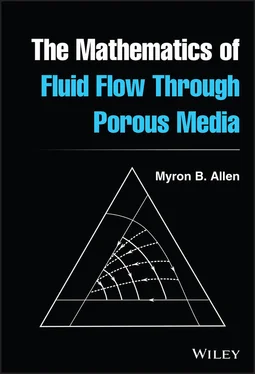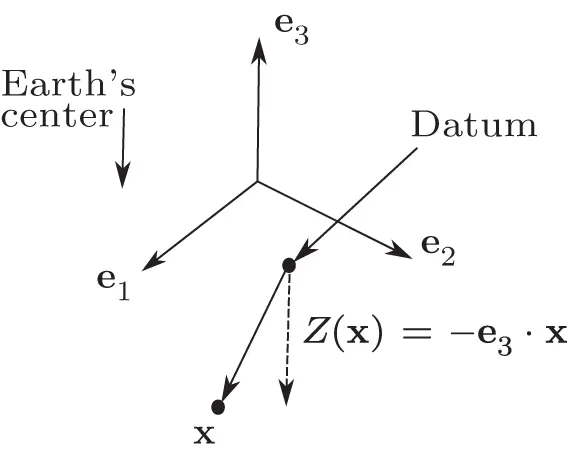Myron B. Allen, III - The Mathematics of Fluid Flow Through Porous Media
Здесь есть возможность читать онлайн «Myron B. Allen, III - The Mathematics of Fluid Flow Through Porous Media» — ознакомительный отрывок электронной книги совершенно бесплатно, а после прочтения отрывка купить полную версию. В некоторых случаях можно слушать аудио, скачать через торрент в формате fb2 и присутствует краткое содержание. Жанр: unrecognised, на английском языке. Описание произведения, (предисловие) а так же отзывы посетителей доступны на портале библиотеки ЛибКат.
- Название:The Mathematics of Fluid Flow Through Porous Media
- Автор:
- Жанр:
- Год:неизвестен
- ISBN:нет данных
- Рейтинг книги:5 / 5. Голосов: 1
-
Избранное:Добавить в избранное
- Отзывы:
-
Ваша оценка:
The Mathematics of Fluid Flow Through Porous Media: краткое содержание, описание и аннотация
Предлагаем к чтению аннотацию, описание, краткое содержание или предисловие (зависит от того, что написал сам автор книги «The Mathematics of Fluid Flow Through Porous Media»). Если вы не нашли необходимую информацию о книге — напишите в комментариях, мы постараемся отыскать её.
, distinguished professor and mathematician Dr. Myron B. Allen delivers a one-stop and mathematically rigorous source of the foundational principles of porous medium flow modeling. The book shows readers how to design intelligent computation models for groundwater flow, contaminant transport, and petroleum reservoir simulation.
Discussions of the mathematical fundamentals allow readers to prepare to work on computational problems at the frontiers of the field. Introducing several advanced techniques, including the method of characteristics, fundamental solutions, similarity methods, and dimensional analysis,
is an indispensable resource for students who have not previously encountered these concepts and need to master them to conduct computer simulations.
Teaching mastery of a subject that has increasingly become a standard tool for engineers and applied mathematicians, and containing 75 exercises suitable for self-study or as part of a formal course, the book also includes:
A thorough introduction to the mechanics of fluid flow in porous media, including the kinematics of simple continua, single-continuum balance laws, and constitutive relationships An exploration of single-fluid flows in porous media, including Darcy’s Law, non-Darcy flows, the single-phase flow equation, areal flows, and flows with wells Practical discussions of solute transport, including the transport equation, hydrodynamic dispersion, one-dimensional transport, and transport with adsorption A treatment of multiphase flows, including capillarity at the micro- and macroscale Perfect for graduate students in mathematics, civil engineering, petroleum engineering, soil science, and geophysics,
also belongs on the bookshelves of any researcher who wishes to extend their research into areas involving flows in porous media.


 ,
,  ,
,  , and
, and  . The symmetry of the stress tensor,
. The symmetry of the stress tensor,  , reduces the number of independent scalar functions to 13. From the mathematical point of view, a well posed problem involving Eqs. (2.10)requires
, reduces the number of independent scalar functions to 13. From the mathematical point of view, a well posed problem involving Eqs. (2.10)requires  additional equations to close the system. We call these equations constitutive relationships.
additional equations to close the system. We call these equations constitutive relationships. and velocity
and velocity  , then we need to specify constitutive relationships for the three scalar functions defining the body force
, then we need to specify constitutive relationships for the three scalar functions defining the body force  and the six independent scalar functions
and the six independent scalar functions  that define the matrix representation of the stress tensor. This book examines only a small number of constitutive relationships, chosen from the myriad that scientists and engineers have developed to model the remarkable variety of materials found in nature.
that define the matrix representation of the stress tensor. This book examines only a small number of constitutive relationships, chosen from the myriad that scientists and engineers have developed to model the remarkable variety of materials found in nature.
 .
. . Here
. Here  m
m  denotes the gravitational acceleration, which varies across Earth's surface, and we adopt a Cartesian coordinate system in which
denotes the gravitational acceleration, which varies across Earth's surface, and we adopt a Cartesian coordinate system in which  points away from Earth's center, as shown in Figure 2.8.
points away from Earth's center, as shown in Figure 2.8. as the mapping that assigns to each spatial point
as the mapping that assigns to each spatial point  its depth
its depth  below some datum, at which
below some datum, at which  , as drawn in Figure 2.8. We often take the datum to be Earth's surface, but other choices are possible. Observe that
, as drawn in Figure 2.8. We often take the datum to be Earth's surface, but other choices are possible. Observe that
 . Therefore, we write the constitutive equation for the body force as
. Therefore, we write the constitutive equation for the body force as  .
. enjoys a richer set of possibilities. The simplest is the constitutive relationship for an ideal fluid, in which
enjoys a richer set of possibilities. The simplest is the constitutive relationship for an ideal fluid, in which  . Here,
. Here,  is a scalar function called the mechanical pressure, having dimension
is a scalar function called the mechanical pressure, having dimension  (force/area). The SI unit for pressure is 1 pascal, abbreviated as 1 Pa and defined as 1 kg
(force/area). The SI unit for pressure is 1 pascal, abbreviated as 1 Pa and defined as 1 kg 
 . The symbol
. The symbol  denotes the identity tensor. With respect to any orthonormal basis, the stress of an ideal fluid has matrix representation
denotes the identity tensor. With respect to any orthonormal basis, the stress of an ideal fluid has matrix representation
 . We describe this fact by saying that the stress tensor is isotropic. Section 3.7 discusses isotropic tensors in more detail.
. We describe this fact by saying that the stress tensor is isotropic. Section 3.7 discusses isotropic tensors in more detail.










